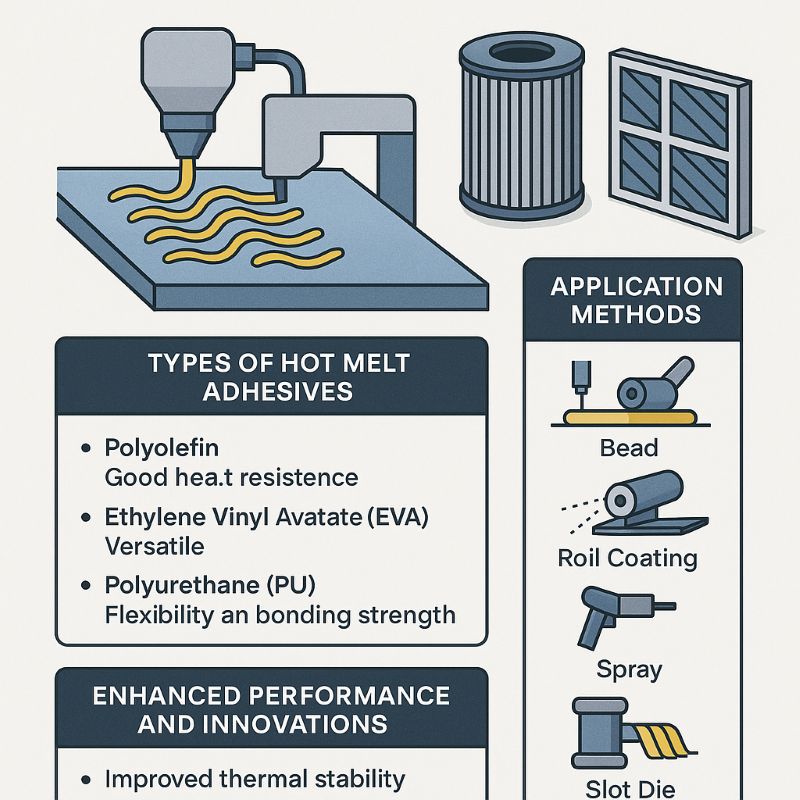
Defining Hot Melt Adhesives
Types of Hot Melt Adhesives
Importance in Filter Manufacturing
Application Methods for Filters
Latest Trends in Adhesive Use
Strategies for Effective Application
Future Innovations in Adhesives
Hot melt adhesives are thermoplastic materials applied in a molten state that solidify upon cooling to create durable bonds. In filter manufacturing, these adhesives support high-speed production and ensure strong attachment between media and structural elements. Their fast setting time and long-lasting performance make them ideal for securing filter components and maintaining product reliability.
Hot melt adhesives used in filter production include several common types, each suited to specific requirements. EVA-based adhesives are valued for affordability and ease of use. Polyolefin adhesives are preferred for chemical resistance in aggressive environments. Polyurethane-based variants offer excellent flexibility and mechanical strength. Each type supports different filtration applications based on its thermal and mechanical characteristics.
In modern filter production, hot melt adhesives are integral to maintaining assembly efficiency and product quality. They allow for quick bonding of filter media to frames or enclosures, improving the structural integrity and performance consistency of the final product. Their use supports high-throughput production while ensuring dependable filtration standards across industries.
Application techniques for hot melt adhesives vary based on design and manufacturing conditions. Roller coating is used for wide surfaces and provides uniform adhesive coverage. Spray coating is suitable for detailed filter geometries requiring precision. Slot-die methods enable consistent adhesive layers across substrates. These methods enhance operational consistency and ensure strong, clean bonds in filter assemblies.
Current trends in filter adhesive technology emphasize improvements in heat resistance and environmental responsibility. New formulations aim to reduce VOC emissions and increase temperature stability, supporting evolving safety and sustainability requirements. These innovations reflect a shift toward more adaptable and eco-friendly adhesive solutions in industrial applications.
Effective use of hot melt adhesives begins with matching the adhesive type to the performance demands of the filter. EVA-based options may suit high-speed general assembly lines, while polyamide or polyolefin-based types serve better in chemically harsh or high-heat settings. Precision in application method and temperature control ensures strong bonding and consistent product outcomes.
The future of adhesive technology in filter manufacturing focuses on advanced formulations that improve strength, flexibility, and environmental compatibility. Emphasis is placed on bio-based or low-emission materials, enhanced mechanical properties, and process automation compatibility. These developments aim to support sustainable manufacturing while meeting increasingly complex product requirements.
What are hot melt adhesives?
Hot melt adhesives are thermoplastic compounds that are applied in molten form and solidify to form strong bonds. They are widely used in filter manufacturing for fast, durable assembly.
What types of hot melt adhesives are used in filter manufacturing?
Common types include EVA (for cost-effectiveness), polyolefin (for chemical resistance), and polyurethane (for flexibility and strength).
Why are hot melt adhesives important in filter manufacturing?
They enhance production speed, improve bonding reliability, and help maintain product integrity, which is critical in filtration systems.
What are the common application methods?
Roller coating (for wide areas), spray coating (for precision), and slot-die coating (for uniform layering) are most common in filter adhesive application.
What are the latest trends in hot melt adhesive use?
Recent trends include improving thermal resistance, reducing environmental impact, and developing adhesives suited for complex filter configurations.
How can manufacturers ensure effective adhesive application?
By selecting the appropriate adhesive type, using the right application method, and maintaining consistent process control during production.
What innovations are expected in the future?
Expect improvements in eco-friendly formulations, high-temperature resistance, and integration with automated manufacturing systems.
Are specific products or brands recommended?
This guide provides general information. When selecting adhesives, consult technical data sheets and test compatibility with your filter components.